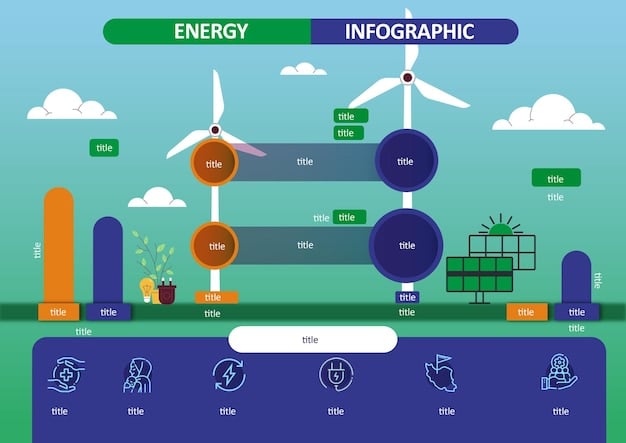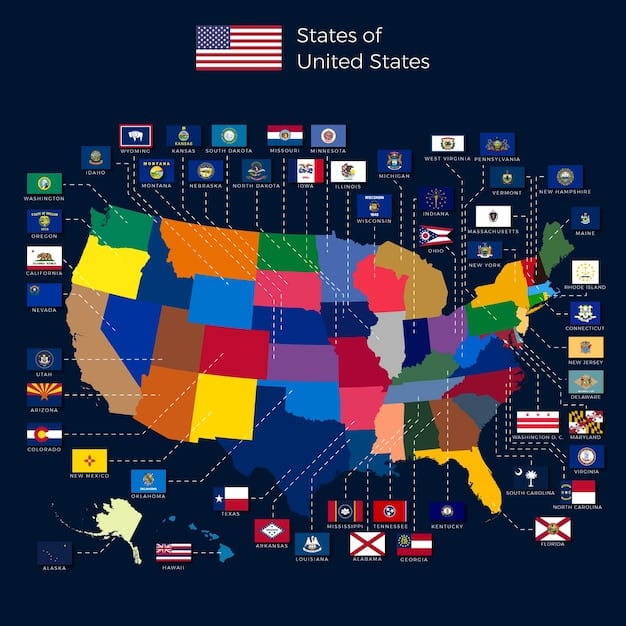Renewable Energy Certificates (RECs): Your 2025 Profit Guide

Renewable Energy Certificates (RECs) are market-based instruments that certify the bearer owns one megawatt-hour (MWh) of electricity generated from a renewable energy resource, offering a way for individuals and businesses to support green energy and potentially profit through trading.
Navigating the world of renewable energy can seem complex, but understanding **Renewable Energy Certificates (RECs): A 2025 Guide to Understanding and Trading Them for Profit** can unlock opportunities to support green initiatives and potentially generate income.
Understanding Renewable Energy Certificates (RECs)
Renewable Energy Certificates (RECs) are crucial tools for promoting and tracking renewable energy consumption. They represent the environmental attributes of electricity generated from renewable sources.
Think of RECs as proof that a certain amount of electricity was generated from a renewable source, like solar, wind, or hydro. This allows consumers and businesses to support renewable energy, even if they can’t directly purchase it from a renewable generator.
What RECs Represent
Each REC represents one megawatt-hour (MWh) of electricity generated from a renewable energy source. They are sometimes called “green tags,” “renewable energy credits,” or “tradable renewable certificates.”
When a renewable energy facility generates electricity, it can sell both the electricity itself and the REC associated with that electricity.
The Purpose of RECs
RECs serve several important purposes:
- Tracking renewable energy consumption: RECs allow consumers and businesses to verifiably claim that they are using renewable energy.
- Supporting renewable energy development: By purchasing RECs, consumers and businesses provide financial support to renewable energy generators.
- Meeting regulatory requirements: Many states have renewable portfolio standards (RPS) that require utilities to obtain a certain percentage of their electricity from renewable sources. RECs are used to demonstrate compliance with these standards.

RECs play a vital role in driving the growth of the renewable energy market by providing a mechanism for valuing and trading the environmental benefits of renewable electricity.
Who Uses Renewable Energy Certificates?
The use of RECs is widespread, involving a variety of stakeholders who contribute to and benefit from the renewable energy market. Understanding who these users are provides insight into the diverse applications and impacts of RECs.
From individual consumers to large corporations and utilities, RECs offer a flexible and effective way to support renewable energy initiatives.
Residential Consumers
Homeowners can purchase RECs to offset their electricity consumption with renewable energy. This allows them to support green energy even if their utility doesn’t offer a specific renewable energy program.
By buying RECs, residential consumers can reduce their carbon footprint and contribute to a cleaner environment.
Businesses
Companies increasingly purchase RECs to meet sustainability goals, reduce their environmental impact, and enhance their corporate social responsibility (CSR) efforts. RECs can help businesses achieve carbon neutrality or offset their electricity usage from non-renewable sources.
Many businesses also use RECs to demonstrate their commitment to renewable energy to customers, investors, and other stakeholders.
Utilities
Utilities often use RECs to comply with state renewable portfolio standards (RPS). These standards mandate that a certain percentage of the electricity they provide comes from renewable sources.
RECs provide a flexible and cost-effective way for utilities to meet these regulatory requirements and support the development of renewable energy projects.
Government Agencies
Government entities at the federal, state, and local levels may purchase RECs to meet their internal sustainability goals.
This can include offsetting the electricity consumption of government buildings, facilities, and operations with renewable energy.
Essentially, RECs are used by anyone wanting to document and support their investment in renewable energy generation.
How Renewable Energy Certificates Work
Understanding the mechanics of how RECs are created, tracked, and traded is essential for anyone looking to participate in the renewable energy market. The process involves several key steps and players.
Here’s a breakdown of how RECs work from generation to retirement.
REC Generation
When a renewable energy facility generates one megawatt-hour (MWh) of electricity, it creates one REC. The REC is a separate and distinct commodity from the electricity itself.
The REC represents the environmental attributes associated with that MWh of renewable energy, such as reduced emissions and other environmental benefits.
Tracking and Registration
RECs are tracked through regional or national registries, such as the North American Renewables Registry (NAR), Midwest Renewable Energy Tracking System (M-RETS), and ERCOT in Texas.
These registries assign each REC a unique serial number and track its ownership as it is bought, sold, and transferred.
REC Trading
RECs are bought and sold in both voluntary and compliance markets. The price of RECs is determined by supply and demand, and can vary depending on the type of renewable energy, location, and other factors.
Consumers and businesses can purchase RECs from renewable energy generators, brokers, or retailers.
REC Retirement
Once a consumer or business uses a REC to claim renewable energy consumption, the REC is “retired” in the registry. This prevents it from being resold or used again.
Retirement ensures that the environmental benefits associated with the REC are only claimed once. This process also helps maintain trust in the REC system.

The whole point of the exchange is to provide clarity for consumers and government agencies and to prevent double counting of renewable energy usages.
Benefits of Trading Renewable Energy Certificates
Trading RECs offers a variety of benefits to different stakeholders, from renewable energy generators to consumers and businesses. These benefits contribute to the growth and sustainability of the renewable energy market.
Let’s explore some of the key benefits.
Financial Incentives for Renewable Energy Generators
RECs provide an additional revenue stream for renewable energy generators, making renewable energy projects more financially viable. This encourages investment in new renewable energy capacity.
The sale of RECs can help offset the costs of building and operating renewable energy facilities.
Meeting Sustainability Goals
RECs enable businesses and consumers to meet their sustainability goals and reduce their carbon footprint. By purchasing RECs, they can offset their electricity consumption with renewable energy.
This allows them to demonstrate their commitment to environmental stewardship and corporate social responsibility.
Compliance with Regulatory Requirements
RECs provide a cost-effective way for utilities to comply with state renewable portfolio standards (RPS). They can purchase RECs instead of building or acquiring their own renewable energy facilities.
This flexibility helps utilities meet their regulatory obligations without incurring excessive costs.
- Supporting the development of new renewable energy projects.
- Meeting regulatory standards for electrical companies.
- Providing an inexpensive way to document renewable energy usage.
Overall, trading RECs offers a range of benefits that contribute to the growth and sustainability of the renewable energy market.
Risks and Challenges in the REC Market
While RECs offer many benefits, it’s important to be aware of the risks and challenges associated with the REC market. These challenges can affect the credibility, effectiveness, and overall success of the system.
Here are some of the key issues to consider.
Double Counting
One of the primary risks is double counting, where the environmental benefits of a renewable energy project are claimed more than once. This can undermine the integrity of the REC system.
Robust tracking and registration systems are essential to prevent double counting.
Lack of Transparency
The REC market can sometimes lack transparency, making it difficult for consumers and businesses to understand the true value and impact of their REC purchases. A lack of information about the source, type, and location of renewable energy can erode trust in the system.
Greater disclosure and standardization could enhance transparency.
Volatility in REC Prices
REC prices can be volatile, depending on factors such as supply and demand, regulatory changes, and technological advancements. This can create uncertainty for both buyers and sellers of RECs.
Hedging strategies and long-term contracts can help mitigate price volatility.
Defining “Acceptable” Renewable Generation
The definition of renewable generation can vary from one region to the next. For example, in a region with abundant hydroelectric power, electricity generated from hydroelectric dams is cheap, but can also be disruptive to local ecosystems. Other renewable sources, like solar, may not be available in the region.
- Ensuring that a REC is viable to purchase.
- Double-check claims made by energy companies.
- Understanding the differences in “renewable” energy generation.
By addressing these challenges, the REC market can become more effective, transparent, and reliable, contributing to a sustainable energy future.
Future Trends in Renewable Energy Certificates
The REC market is constantly evolving, driven by technological advancements, regulatory changes, and increasing demand for renewable energy. Looking ahead, several key trends are expected to shape the future of RECs.
Here are some of the trends to watch for.
Increased Demand
As more businesses and consumers commit to sustainability goals, demand for RECs is likely to increase. This will drive the growth of the REC market and support the development of new renewable energy projects.
Corporate social responsibility efforts and regulatory requirements will continue to fuel demand.
Technological Innovations
Advancements in renewable energy technologies, such as solar, wind, and energy storage, will impact the REC market. New technologies may lead to lower costs and increased efficiency, making renewable energy more competitive.
This in turn can affect REC prices and market dynamics.
Standardization and Harmonization
Initiatives to standardize and harmonize REC tracking and certification systems are underway. This will improve transparency, reduce transaction costs, and facilitate cross-border trading of RECs.
Greater standardization will make the REC market more efficient and accessible to participants.
The Increase in Alternative RECs
Researchers have already found ways to create and track RECs for renewable natural gas and for reducing carbon emissions. As our understanding of climate change grows, expect more alternative instruments to be developed.
With these innovations, expect a massive growth in instruments to document and trade investments in combating climate change.
| Key Aspect | Brief Description |
|---|---|
| 🌱 What are RECs? | Certificates representing the environmental benefits of 1 MWh of renewable energy. |
| 🤝 Who uses RECs? | Utilities, businesses, and individuals looking to support renewable energy. |
| 📈 Trading Benefits | Financial incentives for generators and compliance for utilities. |
| 🔮 Future Trends | Increased demand, technological innovations, and greater standardization. |
Frequently Asked Questions
▼
A REC represents the environmental attributes of one megawatt-hour (MWh) of electricity generated from a renewable energy source. It’s a tradable instrument that can be bought and sold separately from the electricity itself.
▼
RECs can be purchased and used by a wide range of entities, including residential consumers, businesses, utilities, and government agencies, all looking to support renewable energy and meet sustainability goals.
▼
RECs are tracked through regional or national registries such as NAR, M-RETS, and ERCOT. These registries assign each REC a unique serial number and monitor its ownership to protect against fraud and abuse.
▼
Key risks include possibilities for double counting, a lack of market transparency concerning REC pricing and sources, and volatility in the REC market because of the changing economics of green energy generation.
▼
Future trends point towards increased market demand, new technological innovations (especially in storage), initiatives to standardize accounting and valuations, and the development of a more alternative Renewable Energy Certificates.
Conclusion
As we move into 2025, understanding and effectively trading Renewable Energy Certificates (RECs) presents a significant opportunity for businesses, consumers, and utilities to actively participate in and profit from the growing renewable energy sector. By staying informed about market trends, regulations, and potential risks, stakeholders can strategically use RECs to achieve sustainability goals, support green energy projects, and contribute to a cleaner, more sustainable future.





